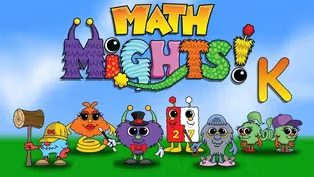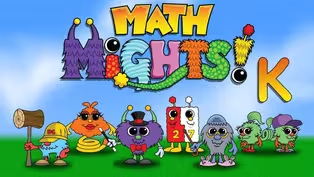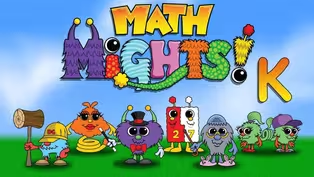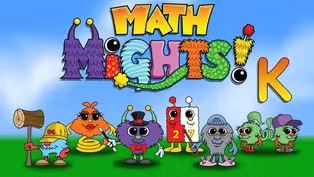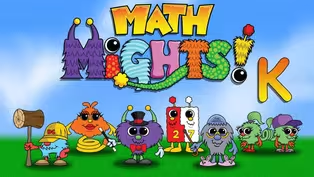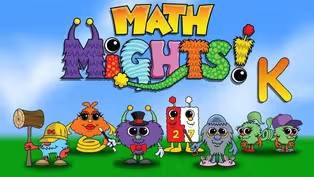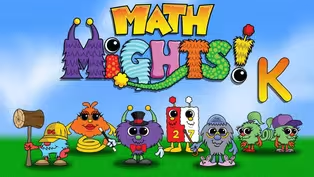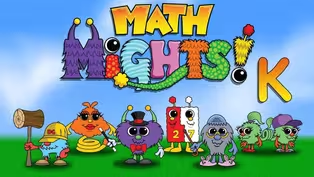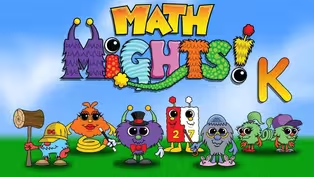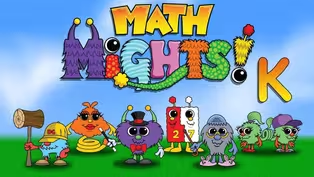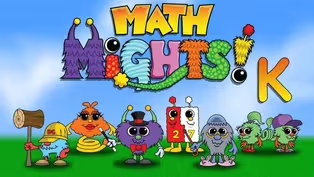Math Mights
More Than One Way to Solve
Season 3 Episode 310 | 15m 59sVideo has Closed Captions
Join Mrs. Gray for a subtraction word problem with Porfessor Barble!
Join Mrs. Gray for a subtraction word problem with Porfessor Barble! Next, get ready to solve Word Problems in more than one way. You will discover a pattern to help you understand word problems that can have multiple answers!
Problems playing video? | Closed Captioning Feedback
Problems playing video? | Closed Captioning Feedback
Math Mights is a local public television program presented by Detroit PBS
Math Mights
More Than One Way to Solve
Season 3 Episode 310 | 15m 59sVideo has Closed Captions
Join Mrs. Gray for a subtraction word problem with Porfessor Barble! Next, get ready to solve Word Problems in more than one way. You will discover a pattern to help you understand word problems that can have multiple answers!
Problems playing video? | Closed Captioning Feedback
How to Watch Math Mights
Math Mights is available to stream on pbs.org and the free PBS App, available on iPhone, Apple TV, Android TV, Android smartphones, Amazon Fire TV, Amazon Fire Tablet, Roku, Samsung Smart TV, and Vizio.
Providing Support for PBS.org
Learn Moreabout PBS online sponsorshipMore from This Collection
Video has Closed Captions
Join Mrs. Gray for a subtraction word problem with Porfessor Barble! (15m 52s)
Video has Closed Captions
Join Mrs. Gray for a subtraction word problem with Professor Barble! (15m 59s)
Video has Closed Captions
Join Mrs. Gray for a subtraction word problem with Professor Barble! (15m 59s)
Compose & Decompose Numbers to 9
Video has Closed Captions
Join Mrs. Gray for a word problem with Professor Barble! (16m 1s)
Break apart pattern block designs
Video has Closed Captions
Join Mrs. Gray for a word problem with Professor Barble! (15m 59s)
Video has Closed Captions
Join Mrs. Gray for a word problem with Professor Barble! (15m 59s)
Addition & Subtraction Expressions
Video has Closed Captions
Match fun story problems with the correct addition or subtraction expression. (16m 15s)
Video has Closed Captions
Join Mrs. Gray for a word problem with Professor Barble! (15m 59s)
Subtraction with Word Problems Part 2
Video has Closed Captions
Join Mrs. Gray & Dotson for a Numeracy Talk with My Counting Buddy Junior! (16m)
Video has Closed Captions
Join Mrs. Gray & Dotson to talk about numbers with My Counting Buddy Junior! (16m)
Addition Word Problems with Quick Draws
Video has Closed Captions
Join Mrs. Gray for Numeracy Talk with Dotson working on conservation to 10. (16m)
Providing Support for PBS.org
Learn Moreabout PBS online sponsorship(cheerful music) (cymbals chiming) (spring boings) (glass squeaking) - [Kids] Math Mights!
- Hi, kindergarten Math Mights.
My name's Mrs. Gray, and I can't wait to do math with you today.
Today, we're going to be doing a word problem with Professor Barble.
We're also going to be talking about more than one way to solve.
Now let's take a look.
Here's our friend Professor Barble now.
(whistle whistles) Professor Barble is an adventurer.
He always wears his thinking cap.
On the top of his thinking cap, there's a pole with four arrows.
Those help Professor Barble remember when he gets to a word problem to stop, and to think which way should he go with his word problem.
Today, we're going to be using the journal template to help us go nice and slow, and think about each piece of our word problem.
Here's Professor Barble's word problem for us today.
"Mrs. Richardson had a pizza party.
They ordered 10 pizzas.
They ate five of the pizzas.
How many pizzas were left?"
Now we're gonna read it again.
And after I read it, I need you to help me read it too.
Then we're gonna add in our chunks to separate out the information.
"Mrs. Richardson had a pizza party.
They ordered 10 pizzas."
This is where we're gonna add in our first chunk, because we got our first piece of information.
"They ate five of the pizzas."
This is where we're gonna add in our second chunk, because we got our second piece of information.
"How many pizzas were left?"
That's where we're gonna add in our third chunk of information.
Now let's take a look at the sentence.
This helps us know what we're solving in our problem.
It says there were, hmm, pizzas left.
When you hear the hmm, that's what we're trying to solve.
We're trying to figure out how many pizza they had left.
Let's go to our work mat and build the problem.
Today, I'm going to be using the two-sided counters.
If you don't have two-sided counters, you could use something else.
You might use coins or pennies or you could use crackers or ripped up pieces of paper.
Anything would be okay to represent the problem.
So they ordered 10 pieces of pizza.
Help me count.
One, two, three, four, five, six, seven, eight, nine, 10.
They ate five pizzas.
We can show that those pizzas are gone by moving them off of the mat.
Help me count.
One, two, three, four, five, there were five pizzas left.
Now let's go to our journal template to do our quick draw of the problem.
There were 10 pizzas.
One, two, three, four, five, six seven, eight, nine, 10.
Five of those pizzas got eaten.
We can show that by crossing them off.
That way we can still see the 10 and that five are gone.
One, two, three, four, five, there were five pizzas left.
Now let's try to organize this in our ten frame.
There was 10 pizzas.
I don't even need to count for this one, because I know that on a 10 frame there are 10 boxes.
So I just need to put a circle in each of the boxes.
Now I'm gonna show that five are gone.
I know on a 10-frame, there are five boxes on the bottom.
So I'm gonna cross off every box on the bottom.
That shows us that if there was 10 and five are gone, there would be five left.
We can also represent this in our number bond.
There were 10 pizzas.
Five of them got eaten, and there were five left.
Five and five are our 10.
Now let's see if we can write our number sentence.
There were 10 pizzas.
We took away or minused five of them, and that equaled five left.
Let's go back to the sentence at the top and see if we can fill in our answer.
There were, hm, pizzas left.
We know that there was five left.
There were five pizzas left.
Kindergarten Math Mights, you worked so hard on that word problem.
Professor Barble would be so proud of us.
Let's take a look at our I Can statement for today.
"I can solve word problems more than one way."
Let's take a look at a word problem I have for you today.
Han squeezed nine pieces of fruit to make juice.
Some of the fruit were oranges.
The rest of the fruit were grapefruits.
How many pieces of fruit were oranges?
How many of the fruit were grapefruits?
Let's take a closer look at all the different ways we could've represented this problem.
I created a list of all the different ways.
The first number shows how many oranges there might've been used.
The second number shows how many grapefruits might've been used.
As you can see, this problem could have been solved in many different ways, because all of them showed that some oranges were used and some grapefruits were used.
And all of them show that there was a total of nine pieces of fruit used to make the juice.
Wow, Math Mights.
You did a great job helping me look at all the different ways that we could've solved that problem.
I want you to take a look at this picture.
These are dates.
A date is a fruit from a date palm tree.
They're kind of like really big raisins Andre and his older brother have eight dates.
They made them into delicious snacks.
Some of the dates were stuffed with cheese.
Some of the dates were stuffed with almonds.
How many dates did they stuff with cheese?
How many dates did they stop with almonds.
Our friends, Javier and Miguel, came back to help us out.
Let's hear what they have to say.
Javier thinks that this is a very tricky problem, because they didn't tell us how many had cheese and how many had almonds.
Our friend, Miguel, wonders that maybe we could represent this story in multiple ways.
I think you got it, Miguel.
We can represent this story in multiple ways.
Let's see how many different ways we can come up with.
We're gonna be using linking cubes to represent the different dates in our story.
If you don't have linking cubes, you could use anything else.
You could even use racks, or maybe pieces of paper, or coins, or a different kinds of snacks.
Those can also be used to represent the dates in our problem.
Let's take a look at our first example.
We might've used seven dates that had cheese and maybe one date had an almond.
I can write this as a number sentence as seven, plus one, equals that eight dates they had all together.
Let's try to make another example.
Maybe there was six dates that had cheese, and two dates that had almonds.
Six plus two equals eight.
Let's keep going.
Maybe there was five dates that had cheese, and three dates that had almonds.
Five plus three equals eight.
There's more.
Maybe there was four dates with cheese and four dates with almonds.
Four plus four equals eight.
Maybe there was three dates with cheese and five dates with almonds.
Three plus five equals eight.
Let's see if we can come up with more ways to show our problem.
Maybe they had two dates with cheese and six dates with almonds.
We could write two plus six equals eight.
Now let's try another one.
Maybe they had one date with cheese, and seven dates with almonds.
One plus seven equals eight.
Wow, we came up with lots of different ways to show that problem.
Here is a table showing the different ways that we made the dates with cheese and the dates with almonds.
Do you see a pattern?
I think I do.
Let's take a closer look at the linking cube trains that we made and see if we can see a pattern.
Do you notice that in our pattern, we have a lot of red, and every time we go down, the red is getting smaller.
And if we look at the blue, every time we go down, the blue is getting bigger.
I notice there's a pattern with our numbers.
If we start at the top, we started with seven dates that had cheese.
And every time we go down to another way, we lose one of those.
It's like we're counting down.
Let's take a look.
So here there was seven with cheese, and then six, five, four, three, two, one.
I know I can't go down to zero, and have eight and zero, because in the problem it told us that some of them had cheese and some of them have almonds.
So I know we can't use zero because zero means none, and that wouldn't match our problem.
Let's take a closer look now at the blue linking cubes.
'Cause I noticing the problem is almost the same, and the numbers are getting bigger each time by one.
Let's take a look.
In the first one, there was only one date that had an almond, and then there was two, and three, four, five, six, seven.
For each of these combinations, the one number is getting smaller and the other number is getting bigger.
By doing that, we are still able to have eight dates each time.
It's just different ways that we are able to put two numbers together to make eight.
Here's another pattern I noticed, looking at the first problem and the last problem, they use the same numbers.
They both have a one and both have a seven.
Let's take a look.
These are just flip-flop facts.
What that means is I can take the seven and the one, and I can just flip the numbers to be one and seven, but it doesn't change how many there are all together.
Look, there's another flip-flop fact.
We have here six and two, and we can flip them to be two and six.
It is still eight, and this one is also still eight.
Here's one more.
This is the numbers five and three.
We can flip flop those to be three and five.
And then number eight, total, didn't change.
Look at this last one.
This last one is four and four.
I could flip flop these if I wanted, and it might look different in the colors.
But when I write the number sentence, the number sentence would stay the same.
So we wouldn't write four plus four twice, we would just write it once and know that we could still flip them, but the number sentence wouldn't change.
Great job today, Math Mights.
Now you're gonna get a chance to do a problem just like we did today.
Today, you're gonna be doing a problem about puppies, and you'll be able to see if you can solve the problem multiple ways.
I hope you had a great time doing math with me today, and I can't wait to see you again soon.
(cheerful music) (bright music) - [Child] sis4teachers.org, (air whooshes) changing the way you think about math.
(upbeat music) - [Narrator] This program is made possible with funding from the Michigan Department of Education Governor's Education Emergency Funds, the State of Michigan, and by viewers like you.


- Home and How To

Hit the road in a classic car for a tour through Great Britain with two antiques experts.










Careers that Work

Support for PBS provided by:
Math Mights is a local public television program presented by Detroit PBS
